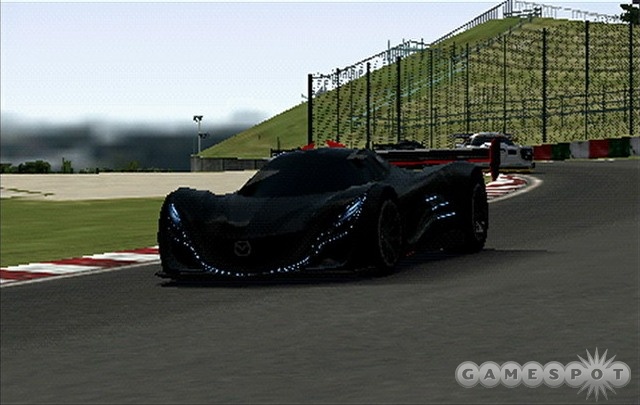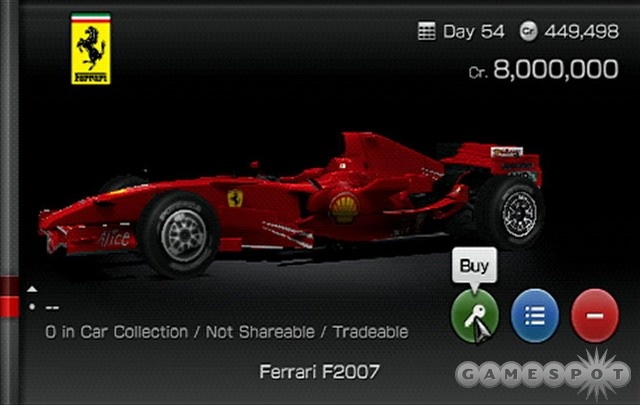More than five years and a couple of title changes after it was announced, Gran Turismo has finally arrived on the PSP. The first handheld iteration of "the real driving simulator" isn't as fully featured as some of its predecessors, and the lack of a structured Career mode is particularly unfortunate. However, with over 800 realistically handling cars of all kinds to put through their paces on 35 impressively varied tracks, an engaging Challenge mode, and some decent multiplayer options, there's certainly no shortage of quality content.
In the absence of a Career mode, much of your time with Gran Turismo is spent setting up and competing in your own one-off events. All of the impressively varied tracks are available from the get-go, but you start with only one car in your collection, so job one is to make some money for automobile acquisition. Prize money is awarded for podium positions in any race that you care to create, and given that there only a measly four cars competing, it's rarely difficult to finish in the top three. The easiest way for you build up your bank balance early on, though, is to spend some time in the Challenge mode.
Much like the license tests in older Gran Turismo games, challenges include everything from driving around a single corner to overtaking multiple opponents while navigating a treacherous series of "S" bends. Many of these challenges double as instructional sessions that will improve your race craft not only in Gran Turismo, but also in any racing game to which real-life racing theory can be applied. It's an incredibly humbling experience to race around a hairpin and be told that in the space of just one turn, you're two whole seconds slower than you should be, but with practice (and some help from a racing line and braking zone indicator that's superimposed on the asphalt), you can shave those seconds off. Unlike some of its predecessors' similar offerings, most of Gran Turismo's challenges are easy to beat at the speed required to earn a bronze trophy. If you want to earn gold trophies and the significantly larger prize moneys attached to them, though, you're in for a much more challenging ride.

Improving your driving skills and earning prize money along the way are pretty good incentives for playing through the Challenge mode, which is just as well because other tangible rewards are sadly few and far between. Early on, you can unlock a customizable soundtrack feature that lets you listen to MP3s while you play, but beyond that and a great-looking ending movie (that's also a trailer for GT5) that you can rewatch at any time, your only reward for beating challenges is access to more challenges. It's neat that some of the bonus challenges afford you time at the controls of cars you might otherwise miss out on or overlook, but it's still no substitute for a full-fledged Career mode.
With some money in the bank, you'll no doubt be eager to put it to work by adding some cars to your collection. Selecting the "Dealerships" option from the main menu, you might initially be surprised to find that only four manufacturers are represented and that none of them ever have more than 10 cars in stock simultaneously. Don't worry, though, there are plenty more where those came from; it's just that different manufacturers rotate in and out randomly as you spend time playing, and their stock changes. It's tough having to wait for your favorite dealer to show up, especially if you've already seen it once but didn't have enough money for the car that you wanted at the time. However, this limited access to cars actually makes the collection aspect much more compelling. If you're impatient, you might spend your money on cars that you wouldn't have looked twice at had your dream car been available. If you have no problem waiting for your dream car to show up, you'll appreciate it all the more when you finally get your hands on it. Either way, you're a winner, and if you choose to share your collection with friends, they'll be winners too.

Every car in Gran Turismo is eligible either for sharing or for trade, and the former option lets you give cars to your friends without losing them from your own collection. Not all cars can be shared in this way, and those that can't--which tend to be those that are rare collector's items in real life--can only be traded on a one-for-one basis. When you and your friends aren't busily exchanging rides, you'll find that silky smooth multiplayer races for up to four players are generally more entertaining than those in single-player. AI drivers, who can be used to make the numbers up in multiplayer races if you wish, don't put up much of a fight early on, but as you prove yourself on certain tracks, you earn the right to face more competitive AI drivers. You also improve the performance of your own AI driver who, should you need to put your PSP down in the middle of an ad hoc race for some reason, will fill in for you the moment you push the start button.
There's no option to set up any kind of race series or tournament for multiplayer games, but Gran Turismo at least does a good job of catering to groups of friends who might have different skill levels if they stick around for multiple races. Professional races don't feature a handicapping system as such, but the order on the starting grid is always in the reverse order from what you finished in for the previous race. Party races take this idea a step further by employing a staggered start system to give players who are having a hard time keeping up a head start, and if that doesn't work, increasing that advantage for subsequent races until they can be competitive. Shuffle races are one of the more interesting ideas to grace a racing game in recent memory: In them, players are randomly assigned cars from a pool, and if a player wins a race, he starts the next one in a slower car while his last-placed opponent gets a better ride. None of these options guarantee close competitive racing, of course, but they definitely increase the odds that you and your friends will spend some time jostling for position at some point.
Races are the only gameplay option available to you during multiplayer sessions, but when playing solo, you can also choose to set fastest laps in time trials or put your driving skills to the test in a different way with drifting events. Here, you can choose from any of 45 track variants (or at least portions of them) and earn points for performing drifts in sections that are marked with flags. It's a lot of fun, and because every point you earn is doubled and turned into money at the end of the event, it can be a good way to make some quick bucks. This is especially true on the dirt and snow tracks where--with a little practice--high-scoring drifts can be performed with relative ease. You can even enter a drifting event at the Nurburgring, though you only get to drive around a tiny portion of the gigantic circuit.
Predictably, the Nurburgring is tough to top where the course selection is concerned, but in Gran Turismo, there are plenty of other great locations to race as well. Tracks are divided up into four categories for ease of navigation. Real circuits include such favorites as Suzuka, Twin Ring Motegi, Laguna Seca, Infineon, and the Fuji Speedway. City courses take in such exotic locales as Seoul, Tokyo, Paris, and New York. Original (though technically recycled) courses are recognizable from previous GT games, like Autumn Ring, Grand Valley, Apricot Hill, and Deep Forest. And finally, there are eight "dirt and snow" courses that run the gamut from an ice arena and one set in the Swiss Alps to dusty tracks in Tahiti and the Grand Canyon. These tracks don't just look varied, either; they offer some very different challenges that continuously test your skill set.

If you feel like you're pushing your skills to the limit but still struggling to win races, you might be able to improve your times by tuning your car's performance. Unlike previous GT games, in which you could purchase a plethora of upgrades for your cars and then spend hours fine-tuning them, here, you get to tinker with a maximum of eight variables. These include power, weight, aerodynamics, ride height, suspension, and the like. Any changes that you make can have a very noticeable effect when you take your ride back out on the track, but it's worth mentioning that, for some reason, only up to 30 cars that you've designated as favorites in your collection can be tuned this way. That should be more than enough for most people, but it represents only a fraction of the cars that you'll acquire if you play for any length of time.
Gran Turismo's presentation is uniformly slick, and it's incredibly easy to access whichever content you feel like playing with in the uncomplicated menus. Car models look sharp and nicely detailed whether you’re checking them out in your garage or taking them out to race. The tracks and their surroundings are also impressive, and though they don't always hold up to close scrutiny, they're generally whizzing by quickly enough for you not to notice.

While it lacks a number of the features that the series was built on, Gran Turismo still has a lot to offer anyone who's ever had a poster of a car up on his wall or dreamed of taking a supercar for a test drive. It's also worth noting that although this is a good game in its own right, it serves as a tantalizing appetizer to come before the Gran Turismo 5 main course that's due out on the PlayStation 3 next year. Because the cars you collect on your PSP can be transferred to your GT5 profile when the time comes, any of you who are planning on getting that game are going to want to spend a lot of time with this one. And even if you're not one of those people, Gran Turismo is a game that's likely to keep you coming back for more time and time again.



